Pros
Cons
Introduction
Now it's here and it's firing on all cylinders. The improved graphics and new character classes we saw at PAX have been joined by new vehicles, much more character customization than the first game, an improved skill tree, and the promise of at least four DLC packs to be released by June 2013. Borderlands 2 has taken everything that was great about Borderlands and added a touch of compelling storytelling and a pinch of improved combat mechanics. And yes, more dubstep.
We imagine Borderlands 2 is going to be firing up on Xbox 360s, PS3s, and PCs for at least the next six months, and couldn't be happier that Gearbox has given us more of the same.
This review is based off of over 60 hours of playing the Xbox 360 version of Borderlands 2. The reviewer split time between single-player, split-screen, two, three, and four-player co-op, but focused primarily on a four-player party encompassing the four initial classes. Some impressions may be slightly tailored to the multiplayer experience fostered by the Xbox 360 console, though the majority of the review applies to the PC and PS3 versions of the game as well. Borderlands 2’s gameplay is almost identical to the winning formula from Borderlands, but with enough subtlety and nuance sprinkled in to keep veterans of the first game from feeling too much deja vu.
Gameplay Overview
{{photo_gallery "Gameplay Overview Photos"}}
Borderlands 2 is a peculiar hybrid of FPS and RPG, just like the first game. The game makes use of the Unreal Engine, so anyone who's played Gears of War (or Borderlands) likely has a very good idea of how the game's gunplay feels.
What makes Borderlands 2 unique is what takes place before and after its familiar combat: a colorful, almost manic world populated by unique and larger-than-life characters; dialogue and quests stuffed full of jokes and humor at every turn; and a combat system that is deceptively complex to the point of initially appearing simple.
Choosing Your Character
Just like Borderlands, Borderlands 2 delivers up four initial character classes who are already named, and have pre-set stories that put them where they are on Pandora. You can change your character's name and appearance, but genders and basic functions are locked in.
Axton, the Commando

Axton is the game's "standard model." There are a few different strategies to playing the Commando well, but they primarily focus on the basics: dealing damage while staying alive. He can be thought of as a standard infantryman of sorts, which has led to many players finding him to be less interesting than the other characters (read: boring). His action skill is the Sabre Turret, and he is the spiritual successor to Roland from Borderlands.
Maya, the Siren

Maya is the Borderlands 2 equivalent of a caster/healer. Like her spiritual predecessor, Lilith, Maya is a Siren, a being capable of supernatural powers. Maya is a strong choice for both solo and multiplayer, as her Phaselock ability allows for locking of enemies to exclude them, temporarily, from the battle. There are multiple strategies to Lilith's playstyle, though they focus more on group synergy than those of Axton.
Salvador, the Gunzerker

Salvador, the Gunzerker, could probably be considered the poster-child for Borderlands 2. He was the first officially confirmed character class, and his Gunzerk ability allows him to wield two weapons instead of one, which adds more complexity to the game's combat than one might initially think. Salvador is an equally good choice for group or solo play; he is as capable of "tanking" as he is taking a damage-per-second approach. He can be thought of the spiritual successor to Brick from Borderlands.
Zer0, the Assassin

Zero is the least explained (and most pigeon-holed) character in Borderlands 2. He is a mysterious, possibly robotic assassin whose skills focus either on sniping from long-range or doing melee damage up close. His Deception ability allows him to leave behind a decoy of himself while he disappears completely, which can be used for both offensive and defensive maneuvers. Zero speaks in Haiku, and is the spiritual successor to Mordecai from Borderlands.
Editor's note: Images above are from the Official Borderlands 2 Website. These four playable classes were available at the time of the game's release (September 18th, 2012), though there is a fifth class--Gaige, the Mechromancer--to be released on October 16th.
Choosing Your Appearance
Borderlands 2 has introduced a system for further customizing your chosen character to your personal preferences. The first game allowed for choosing of color palette, but didn't allow any sort of customization beyond that. Borderlands 2 seeks to give players more control over their character's appearance by providing a variety of skins for each character. Each of the four classes starts with some skins already unlocked, and many more (currently about 90) to be unlocked later.
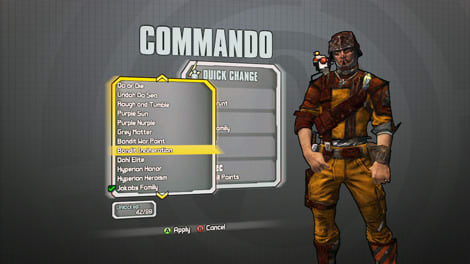
Axton in the “Bandit Incineration” skin, which changes his colors and adds face paint.
Beyond changing body skins, which dictates the character's color scheme and, in some cases, hair or beard color, players also have the choice to swap their head skins for something new. For instance, the Commando class has a variety of head skins dictating various themed appearances, with head skins like "Gallant Grunt" equipping Axton with a soldier's helmet, or "Grizzled Veteran," which turns him into a bald, bearded man with only one eye.

Axton’s “Gallant Grunt” head skin.
Skins can be unlocked by completing in-game challenges (like getting a certain number of critical hits), completing certain quests, or picking them up as loot drops from enemies. Including skins as another reward in the game's constant loot drops (guns, money, eridium, etc.) simply gives players even more incentive to open every single container they come across... which really slows things down in multiplayer. There are also vehicular skins to find and unlock.
The Borderlands 2 Formula
Once you've chosen and created a character class, the game boots up. From here, you're locked into an intro movie and then deposited rudely nearby a familiar 'face': CL4P-TP (Claptrap), the wise-cracking, slightly insane robot from Borderlands. The game's main villain, Handsome Jack, has just welcomed you to Pandora with a healthy dose of explosives.
From here, Borderlands 2 follows the formula laid out in Borderlands quite faithfully. Players, whether solo or alone, will work through a few "introduction" areas with Claptrap in tow, learning the ins and outs of combat, movement, and looting. The game expects by the time you've reached the main city of Sanctuary that you'll have a solid understand of how the game works.
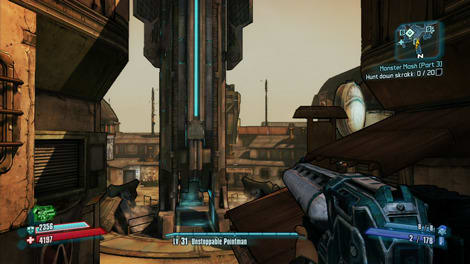
Sanctuary at dawn, as seen from a balcony.
Whether you do the main or side quests, you'll receive XP for killing enemies, finishing quests, and discovering new locations. XP is allocated based on enemy level--so if you're level 10, a level 7 enemy likely won't give you more than 1xp or so per kill. You can take as many quests as you like, and fast travel directly to their areas via the Fast Travel hub.
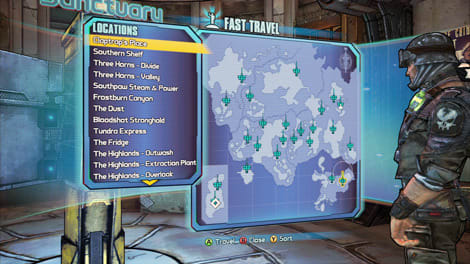
The Fast Travel station allows you to jump instantly to most any area you’ve already visited.
While it's possible to simply go from story mission to story mission and level appropriately (and quickly), you'll blow through the game very fast if you do, and miss out on a lot of good loot, to boot. The game encourages exploration and is peppered with gaming and pop culture references: Gearbox seems determined to reward players for looking around and taking their time.
You can expect a simple, basic formula: Complete a series of quests, horde money and loot, find and use guns you like, level up, allocate skill points to build your character, find better guns/loot, move on to new areas and new quests, all the way through to the end of the game. It's a vicious and addictive cycle of challenge, freedom, and reward. And loot. Sweet, sweet loot.
Loot
{{photo_gallery "Gameplay Part 4 Photos"}}
Loot. Yes, loot. Loot deserves its own section entirely, as the Borderlands series focuses on random drops and variations of weaponry to the same extreme degree as Blizzard's Diablo games. But to really explain why looting is so white-knuckle excitin' in Borderlands 2, we've got to break it down.
Guns
One of the draws of Borderlands was its massive armory. Gearbox claimed the game's procedural engine could generate some 17.75 million different guns, and have claimed that Borderlands 2 contains a much larger amount--they even went so far as to make up a new word ("bazillion") to describe the unfathomable amount of weapons to be found. Guns come in a variety of types: assault rifle, sub-machine gun, shotgun, pistol (or revolver), sniper rifle, and rocket launcher. Guns from various manufacturers feature various manufacturer-based traits, such as always having the largest ammo clip, or exploding upon being reloaded.

This assault rifle adds 50% melee damage. You can probably guess why.
Shields
Shields have been carried over from the first game, and are now both more complementary to combat strategy as well as much more exciting within the realm of a loot-drop. Shields are a buffer between your HP and enemy damage; they recharge automatically, so if you maneuver your character into cover when your shield is depleted, you can avoid taking non-rechargeable health damage. Shields now have various effects, such as emitting a nova of flame upon being depleted, or allowing your gun damage to increase while the shield is fully charged (to reward skilled damage-avoidance).

This shield adds gun damage when it is fully charged.
Class Mods
Class mods are class-specific equipment that augment a class's natural strengths or specific skills. For instance, Axton the Commando has a number of "Pointman" class mods which focus on a front-line assault. They level up throughout the game, gaining in efficacy and diversity of application over time. Your class mod displays beside/beneath your name while playing, so titles in a four-player game might look something like: "Commando, Grizzled Pointman; Siren, Heavenly Nurse; Gunzerker, Armored Titan; Assassin, Deadly Ninja." Not only do they add another element of customization to gameplay, they make your "party role" more obvious to other players you're playing with.
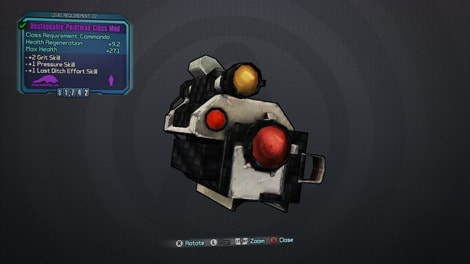
This class mod is specific to the Commando class.
Grenade Mods
If you like to toss grenades into squabbling groups of baddies, grenade mods are worth keeping an eye out for. Without a mod, you'll simply throw a standard grenade and it will stop where it lands and eventually detonate. Most enemies, however, are smart enough to run for cover. Grenade mods allow you to transform your grenades in a variety of ways: some cause grenades to explode into numerous smaller grenades, or stick to enemies or walls, or hover, home in on big targets, and then suck enemies towards them before detonating. BOOM!
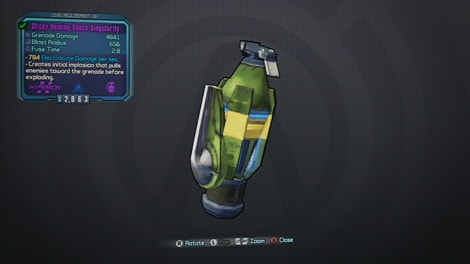
This grenade mod causes grenades to home in, stick to an enemy, suck enemies towards it, and then detonate with shock damage. Pretty cool.
Relics
Relics are non-class specific additions that augment some aspect of your character. Relics can increase shield recharge rate, or add additional damage with a specific gun type or manufacturer type, such as "Shotgun Damage +24%" or "Vladof Guns Fire Rate +15%." Relics, like everything else, are leveled by rarity. They often will augment various abilities or skills with helpfulness that pertains to solo or multiplayer games. For example, solo players may want to look for relics that increase their "Fight For Your Life" duration, as you have no buddies to revive you. Multiplayer players might benefit more from relics that increase "Team Health Regen" or "Team Ammo Regen," which might not be as valuable while playing solo.
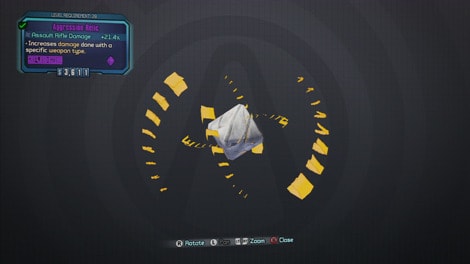
This relic increases assault rifle damage considerably.
The game follows Diablo in that it color-codes item rarity. Borderlands 2 suggests this strange sentence to help players remember rarity order: "When Grandma Burps, Patrick Obeys." Essentially, rarity increases from white, to green, to blue, to purple, to orange. All of the aforementioned lootables will vary by rarity, and could be hiding in any number of large or small chests, enemies, or at the ends of quests. It makes it very hard to ignore that one innocuous locker or mailbox that's on the other side of the map, and Gearbox is well aware of this.
Controls
{{photo_gallery "Controls Photos"}}
Speaking for the Xbox 360 console, Borderlands 2 is a very easy game to control and learn. Its control scheme is more-or-less identical to the control scheme from Borderlands. Players move with the left control stick, look with the right control stick, jump with A, toggle crouch with B, reload with X, and swap weapons with Y (or the directional pad).
Aiming, either through a scope or with iron sights, is executed with the LT button. Firing is--of course--handled by RT. The Left Bumper activates your class's action skill, and the right bumper throws grenades. Most context-sensitive actions, like opening a door, interacting with a chest, or pressing a button, are also handled with the X button.

An overview of the default controls.
Clicking the left stick while moving will initiate a sprint, and the stick only needs to be clicked once: sprinting will continue until the player stops moving or hits an obstacle. Clicking the right stick will enable a class-specific melee attack, which can be used to damage enemies, open certain containers, and initiate a duel with another player.
The controls work well, just as well as they did in Borderlands. The game allocates most important functions to their own buttons, which makes it easy to become swept-up in battle while you subconsciously exercise the Xbox 360 controller to the full extent of its button palette.
Replay Value
{{photo_gallery "Replay Value Photos"}}
Borderlands 2 has a massive amount of replay value. Finishing the game once unlocks "True Vault Hunter Mode," a sort of New Game+ that allows you to play through the story again with your pre-made, pre-leveled character from the first playthrough.
Further, Borderlands 2 introduces "Badass Rank" to the old formula, a tracking system for challenge completion that rewards Badass Tokens to the player. Badass Tokens can be redeemed for a particular skill perk, such as "Melee Damage +.5%" or "Reload Speed +2.1%." Badass Ranks and their bought perks are then carried over to every character associated with the player's Gamertag, Steam Account, or PSN account name. This allows for a sense of cohesion amongst multiple characters and multiple playthroughs, encouraging players to try out at least more than one class and multiple kinds of weapons and strategies to obtain as many Badass Ranks as possible.

Completing challenges awards Badass Rank, which can be “transmuted” into skill bonuses.
The game's loot rarity system tends to make "farming" and playing through boss fights or story missions multiple times in the attempt to force drops of orange (1st tier) or purple (2nd tier) weaponry and equipment. Equipping a very high-level weapon or shield can create gameplay phenomenon that gives huge boosts to a character's efficacy, or makes the game more interesting or fun in some way.
All of this results in a very high level of replayability, providing that you enjoy the game's basic formula enough to invest the time into it. Our one caveat might be that Borderlands 2 does little to reward players who are on the fence about whether they like the game or not. In a sense, the rich get richer, and the poor get poorer.
Additional Content
{{photo_gallery "Additional Content Photos"}}
Borderlands 2, like Gears of War 3, was released with access to a "Season Pass." Purchasing it gives players free, automatic downloads of the four promised DLC packs to be released some time between now and June 2013. There's also already been promise of a fifth playable character class, which will be available at no charge for players who pre-ordered the game. Everyone else will have to pay 800 Microsoft Points, or $9.99 on PC/PS3.
There may be more DLC/character classes added in the future, but knowing about four potential DLC packs and a fifth character right at launch is a good start.

The Season Pass is live right now. The Mechromancer will be available on October 16th.
On top of this, Borderlands 2 features a small but slightly rewarding "slot machine" mini game, allowing players to pay leveled amounts of their collected money for the chance to win Eridium, money, weapons, or a live grenade. The game also contains a number of "arena" style side missions that engage the player/players in levels of increasingly difficult fights against certain enemy types.
There's definitely plenty to do and see in Borderlands 2, besides all of the free-form, mostly humorous content to be discovered through exploration.
Storytelling Overview
{{photo_gallery "Storytelling Overview Photos"}}
Borderlands 2 picks up where Borderlands left off. You again assume the role of a Vault Hunter, a mix of combatant and treasure-hunter who has come to Pandora to seek fortune, fame, etc. You've probably heard this before--in the first game. Fortunately, Borderlands 2 features a story that's much more interesting, and fleshed out, than the first game's. In a series where story definitely takes a backseat to gameplay, that's a good thing.
The opening movie introduces the player to the four Vault Hunters--Axton, Maya, Salvador, and Zer0--as they are ambushed upon a train by Handsome Jack's Hyperion robots. The train is inevitably derailed, and the four are left stranded in the snow with only Claptrap to guide them on their way to the main headquarters of the current resistance movement, aptly named Sanctuary.
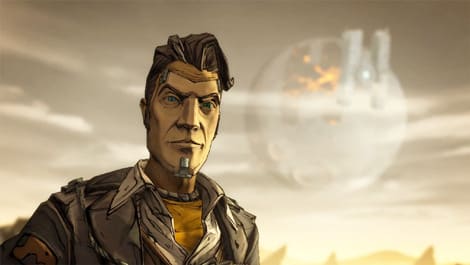
Handsome Jack, eclipsed in front of his Hyperion moon base. (Photo courtesy of http://www.borderlands2.com)
Handsome Jack--who is fabled to be neither "handsome" nor named "Jack"--is the game's main villain, and makes that clear right away. He immediately treats the Vault Hunters with disdain, speaking from his moon base through their earpieces to let them know that they're not wanted on Pandora, or that they ought to meet his diamond-encrusted horse named "Butt Stallion."
From here, the story follows the Vault Hunters as they meet up with NPCs, enemies, and other heroic figures on Pandora (like a few very familiar faces from the first game), seeking the fabled Vault while Handsome Jack does a handsome job at foiling most of their plans. It may sound like a story cliche you've heard a thousand times, but the narrative tale is definitely worth paying attention to: exploring the lore between the first and second game is a rewarding study in the way that Gearbox is building the Borderlands universe, one "ECHOlog" at a time.
Writing
{{photo_gallery "Writing Photos"}}
Most of the game's narration and character/NPC dialogue was written by Anthony Burch, of Hey Ash, Whatcha Playin'? fame. We think Gearbox made an excellent decision in recruiting Mr. Burch as a writer for Borderlands 2. All but the game's most tense and serious moments are loaded with humor that spans the spectrum between being clever and being entirely low-brow.
The amount of pop-culture and meme references in Borderlands 2 are almost uncountable, and span topics like musician Rick Astley, the TV show Firefly, actor Clint Eastwood, the video game Minecraft, astrophysics, the TV shows CSI: Miami and Dr. Who, the Mario Kart games, the film The Dark Knight, and Drake's song "Best I Ever Had." That's just the tip of the iceberg.
The writing's not for everyone, but it's hard to argue with its entertainment value. Borderlands 2 doesn't take itself seriously at all: it intends to be an all-out raucous shooter with over-the-top weapons and characters, and that thematic certainly doesn't stop at the game's writing. We doubt anyone will find 100% of the game's writing funny, but feel like you'd be hard pressed not to find at least one joke that tugged a laugh or a smirk out of you if you played through from start to finish.
Graphics & Atmosphere Overview
{{photo_gallery "Graphics & Atmosphere Overview Photos"}}
Borderlands 2 is described as a "space western," probably because it thrusts the infamous lawlessness of the American West out into the barren wastes of the planet Pandora--and space was likely traversed to get there. It's a curious study in contrasts, and the same can be said of its atmosphere. On the surface, Pandora appears to be a place populated by ne'er-do-wells and brigands, a mix of brutality and run-down despair. Yet the game's insistent humor and strangely optimistic NPCs keep things light and somewhat sunny beneath its gritty exterior.
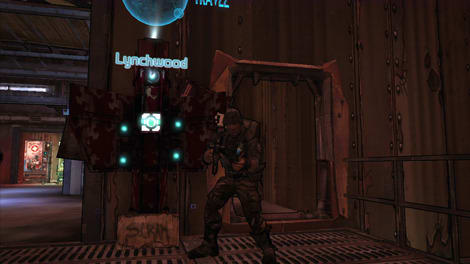
Just a soldier. In an old west town called Lynchwood. Nothing to see here…
This same contrast can be found amongst its overall graphical and atmospheric presentation. The game's violent gunplay, psychotic characters, and general disregard for modesty would create a much more grim and grey atmosphere were it not for its bright, cel-shaded art design. Borderlands 2 takes place across a diverse array of environments: a frozen tundra, a huge glass city, and some acid-filled caverns are a few spoiler-free areas you'll come across while playing. The world moves between day and night on a consistent schedule, and while there aren't a wealth of non-enemy characters outside of the main hub of Sanctuary, the feeling that you're in a real world--with night and day, good and bad, and everything between--lends the game a double-edged majesty.
Art Design
{{photo_gallery "Art Design Photos"}}
Borderlands 2 strikes an interesting balance between being very detailed and being more of a big-picture game, but we think it works. Characters of all types are memorable and fairly over-the-top: Salvador the Gunzerker is a 5'4" giant-torso'd steroid-abusing "Truxican;" whereas Sir Hammerlock is a partially-cybernetic, soft-spoken Victorian gentleman with a penchant for hunting.

Sir Hammerlock seems keen to give us some kind of quest.
There aren't any NPCs who don't have some kind of manic, aberrant appearance or dialogue--sometimes it feels like everyone is a particular shade of crazy, and this contributes heavily to the game's hyper-stylized design, from the little details of dress and appearance, to the larger details of landscape, architecture, and economic structure.
Graphics
{{photo_gallery "Graphics Photos"}}
The graphics in Borderlands 2 are fairly "smoothed over." They aren't a powerhouse of details, but jive more on a scale of being bright and pleasant to look at. Their cel-shaded nature allows the game to (occasionally) impress with brief cinematics and set-piece events, while illustrating gore that's so over-the-top, it never seems realistic enough to be offensive.
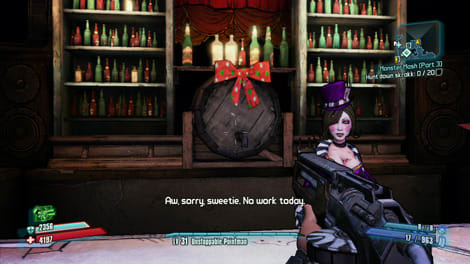
Details tend to look better from a distance, but aren’t too bad up close.
Make no mistake, however, that this game deserves its M-rating quite heavily. It's full of sexual innuendo, violence, and a sort of chaotic craziness that we can't recommend any children or younger teenagers submit themselves to.
Music
{{photo_gallery "Music Photos"}}
Borderlands 2 doesn't bombard the player with constant music. It imbeds music in an almost strategic fashion. When battle begins, music will often trigger only if the battle is of a larger scope or is threatening to the player--sort of in the same vein as Skyrim.
The music that plays is sort of a run-of-the-mill exciting, techno-style beat that's meant to thrum along to the tempo of battle, which is usually fairly hectic and requires a lot of focus. We wouldn't go so far as to say that the music in Borderlands 2 is award-winning, but it's definitely appropriate with the game's overall atmosphere. It sounds a lot like some of the more upbeat music from Portal 2.
There are also radios sprinkled throughout the main hub of Sanctuary and in some less stark quest areas. They tend to play a mix of rock/metal, though sometimes they'll feature advertisements from gun manufacturers or Hyperion. Players have the option to change the radio's stations, but they're rather low in the mix of sounds, and are only highly audible outside of battle pending the absence of sound effects.
Sound Effects
{{photo_gallery "Sound Effects Photos"}}
The most noticeable sound effects in Borderlands 2 are the sounds of various gun types firing and reloading, and the fairly regular chatter of characters as they are wounded, or kill an enemy, or revive another player, or find some very valuable loot. Shotguns kick and boom, SMGs rattle away with consistent treble clicks, and the engines of the game's drivable vehicles whine and scream as you drift through canyons and tundra. There's a sound effect that triggers when your shield has fully recharged, a sound effect of a cash register when you buy or sell an item, and plenty in between that give the game a fully produced feeling. It's a good thing.
Our one gripe with the game's sound channel use--and this may be an individual problem--is that sometimes, Borderlands 2 seems to struggle to produce all of its sounds at once. If you're on a surround-sound headset, you're likely to notice that your friends' voices sometimes cause a particular firing, reloading, or character voice effect to audibly drop out should music also be playing. This can be distracting, or detract from the fullness of the game, but it's a minor problem at most.
Multiplayer Overview
{{section_header}}{{section.name}}{{/section_header}}
{{photo_gallery "Multiplayer Overview Photos"}}
Borderlands 2 may have more personality than a loaded baked potato from TGI Friday's, but it might fall by the wayside as just another Unreal Engine FPS were it not for its unique and well-developed co-operative play.
Like Diablo, Borderlands 2 rewards multiplayer by scaling its loot drops depending on how many people are in your game. A four-player game over PSN or Xbox Live means a lot more enemies, who are harder to kill, but give more experience and (apparently) better loot drops.
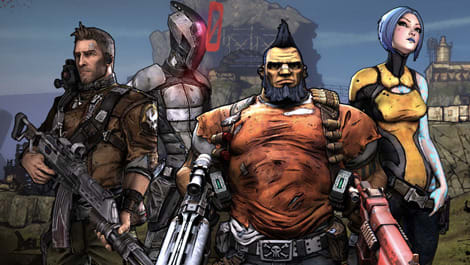
(Photo courtesy of http://www.borderlands2.com)
The synergy between the Commando, Siren, Gunzerker, and Assassin creates a familiar "RPG party" experience. While the game isn't a full-fledged role-playing game, its characters' skill trees tend to allow allocation of skill points that can help or hurt team play. Each character class features a skill tree with three branches. Each branch is dedicated to a different style of play. For example, one of the Siren's branches focuses on healing yourself, health recovery, and healing teammates. This might be a slow way to play through the game while solo, but let's say you're working with a full team:
The Assassin focuses on his sniping skill tree, which enables him to pick off weak enemies from a distance while staying relatively safe. The Commando, Siren, and Gunzerker move in towards the main enemy cluster, while stragglers are picked off by the Assassin. The Commando tosses his Sabre Turret into the middle of the group, which not only deals damage over time to various enemies, it also causes them to focus their attention on the distracting turret that's just magically assembled in front of them. The Commando then takes cover behind some boxes or barrels and begins to focus fire on the "Psycho" enemies who tend to rush the group.
Meanwhile, the Siren has Phaselocked a particularly nasty enemy to get him or her out of the fight momentarily. The Gunzerker then uses his Gunzerk ability to deal massive damage to the Phaselocked baddy, which in turns refills health for each character--though with this strategy, no one has taken much damage yet. The remaining enemies are finished off in an overkill fashion, and then loot is scavenged and collected.
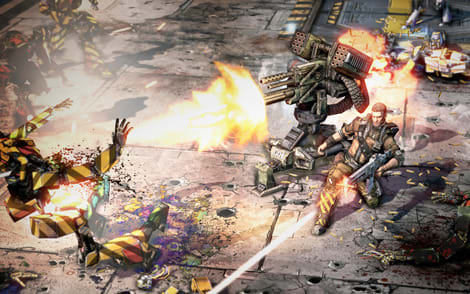
A stylized photo of combat, courtesy of http://www.borderlands2.com
Obviously, this would be an "ideal" way to play, and four players with this amount of focus might actually find the game too easy for their liking. In any case, Gearbox gives action skills like Phaselock and the Sabre Turret a fairly short duration. All of this would have to take place within a 30-60 second window.
Borderlands 2 is perhaps the only multi-platform game that encourages this kind of class mesh and multiplayer functionality, rewarding you for participating in what's possibly the most fun way to play a video game: as a valuable individual within a capable and efficacious unit.
A new vehicle type, the "Bandit Technical," has been added to the second game. It allows up to four players to ride on the same vehicle, and is equipped with a variety of weaponry and ways to combat enemies that pop out to attack you while you're driving from point A to point B. It's also a very effective way to keep your team together and focused in a game that's just slightly capable, at times, of afflicting players with "loot-based ADHD."
All in all, multiplayer is one of the biggest draws of the game, and may be its highest selling point. Dueling your friends for loot, standing shoulder-to-shoulder against a massive boss, and completing the game's endless list of challenges and side quests together is practically the entire top half of Maslow's Hierarchy.
Conclusion
Borderlands 2 deserves at least a nomination for Game of the Year 2012.
First, let's get one thing out of the way. It's a lot--an awful lot--like the first game. The overall gameplay, character synergy, loot system, controls, and humor are nigh identical. Nighdentical. We don't feel, however, that this discounts the game's value in any way. We could sit around and talk about things that Gearbox could have added in to make it better or more interesting or more unique, but we'd rather just go wander Pandora with big guns and little inhibition.
There's an awful lot that Borderlands 2 doesn't do. If you're looking for oodles of character development or humanity expressed through digital means, you're going to be disappointed. If you're looking for a deep, complex, brain-workout style RPG that requires planning ahead and lots of inventory management, you won't find anything like that in Borderlands 2. At its worst, it's immature, shallow even, with predictable twists and a short-lived formula that repeats ad infinitum from Level 1 to Level 50. Without its unique personality, it's basically CoD.
We'll even boldly state that if you didn't like the first game, you shouldn't bother with this one. However, if you did enjoy the first game, then Borderlands 2 is a wise investment.
If Borderlands was a ham-and-cheese sandwich, Borderlands 2 is a turkey-and-duck Dagwood with honey-bourbon mustard, lettuce leafs from a cliffside farm in Nepal, and smaller ham-sandwiches instead of bread. It has stripped nothing from the first game, but has added so much more. There's a larger and more interesting story, a better villain, more in-depth character classes, more rewards for playing alone or with a group, an uncountable amount of lootable items, more risque and contemporary humor, an actual trade system, more over-the-top boss fights, and exponentially increased replay value and multi-character cohesiveness via "Badass Rank." Oh, and about 87 billion guns.
If you like: Borderlands; space; westerns; space westerns; dancing; robots; dancing robots; guns; grenades; guns-that-shoot-grenades; or manically idiotic jokes like those attempted in this conclusion, then Borderlands 2 is for you.
Photo Gallery
{{photo_gallery "Gameplay Overview Photos", "Gameplay Part 1 Photos", "Gameplay Part 2 Photos", "Gameplay Part 3 Photos", "Gameplay Part 4 Photos", "Gameplay Part 5 Photos", "Gameplay Part 6 Photos", "Gameplay Part 7 Photos", "Gameplay Part 8 Photos", "Controls Photos", "Replay Value Photos", "Additional Content Photos", "Pacing & Flow Photos", "AI Photos", "Storytelling Overview Photos", "Writing Photos", "Plot & Player Choices Photos", "Acting Photos", "Cinematics Photos", "Graphics & Atmosphere Overview Art Photos", "Art Design Photos", "Graphics Photos", "Music Photos", "Sound Effects Photos", "Multiplayer Overview Photos", "Competitive Multiplayer Photos", "Co-Op Multiplayer Photos", "Game Modes Photos", "Customizability Photos", "Matchmaking Photos", "Community Features Photos"}}
Meet the tester
Lee was Reviewed's point person for most television and home theater products from 2012 until early 2022. Lee received Level II certification in TV calibration from the Imaging Science Foundation in 2013. As Editor of the Home Theater vertical, Lee oversaw reviews of TVs, monitors, soundbars, and Bluetooth speakers. He also reviewed headphones, and has a background in music performance.
Checking our work.
Our team is here to help you buy the best stuff and love what you own. Our writers, editors, and experts obsess over the products we cover to make sure you're confident and satisfied. Have a different opinion about something we recommend? Email us and we'll compare notes.
Shoot us an email

